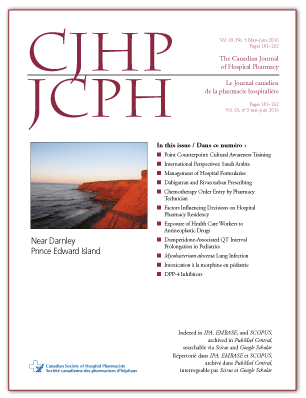Appropriateness of Dabigatran and Rivaroxaban Prescribing for Hospital Inpatients
DOI:
https://doi.org/10.4212/cjhp.v69i3.1555Keywords:
anticoagulants, prescribing patterns, medication safety, dabigatran, rivaroxabans, habitudes de prescription, sécurité des medicaments, rivaroxabanAbstract
ABSTRACT
Background: Recent approval of the new oral anticoagulants dabigatran and rivaroxaban has led to rapid changes in anticoagulant prescribing practices. Postmarketing reports have highlighted safety concerns with these agents, and their use outside of evidence-based recommendations was noted at the authors’ centre.
Objectives: To determine the incidence of and risk factors associated with inappropriate prescribing of dabigatran and rivaroxaban.
Methods:This retrospective cohort study investigated randomly selected dabigatran or rivaroxaban prescriptions for patients admitted to a tertiary teaching hospital between January 2010 and December 2012. Appropriateness of prescribing was determined from the documented indication, drug dosage, patient’s renal function, and presence of drug interactions, if applicable.
Results: Among a total of 321 medication orders reviewed, the incidence of inappropriate use was 31.2% (34/109) for dabigatran and 26.9% (57/212) for rivaroxaban. Of the 97 reasons for inappropriate use that were identified, the most common were prescribing for an unapproved indication (49/97 [50.5%]), concomitant prescribing of another anti -coagulant (22/97 [22.7%]), and high prescribed dose (9/97 [9.3%]). The prescribing service was found to be an independent risk factor for inappropriate prescribing (p = 0.041). Corrections were made to 23.1% (21/91) of the incorrect regimens before hospital discharge. In a sensitivity analysis using calculated ideal body weight to estimate renal function, the overall incidence of inappropriate prescribing increased to 31.5% (101/321).
Conclusions: The proportion of patients with inappropriate prescribing of dabigatran or rivaroxaban in clinical practice was higher than expected. Educational interventions and pharmacy-led initiatives with a focus on appropriate indications, concomitant anticoagulant prescribing, and review of dosage regimens are recommended to improve patient safety.
RÉSUMÉ
Contexte : La récente approbation de deux nouveaux anticoagulants oraux, le dabigatran et le rivaroxaban, a mené à de rapides changements dans les habitudes de prescription pour l’anticoagulothérapie. Des rapports de pharmacovigilance ont relevé des risques pour la santé relativement à ces agents. De plus, on a noté au centre où travaillent les auteurs que ces médicaments n’étaient pas toujours utilisés selon les recommandations fondées sur des données probantes.
Objectifs : Déterminer quelle est l’incidence des prescriptions inadéquates de dabigatran et de rivaroxaban et quels sont les facteurs de risque qui y sont associés.
Méthodes : La présente étude de cohorte rétrospective a examiné des ordonnances choisies au hasard de dabigatran ou de rivaroxaban, lesquelles étaient destinées à des patients admis dans un hôpital universitaire de soins tertiaires entre janvier 2010 et décembre 2012. La pertinence des prescriptions était établie à l’aide des informations consignées sur l’indication, la posologie, la fonction rénale du patient et la presence d’interactions médicamenteuses, le cas échéant.
Résultats : Parmi l’ensemble des 321 ordonnances analysées, l’incidence d’utilisation inadéquate était de 31,2 % (34/109) pour le dabigatran et de 26,9 % (57/212) pour le rivaroxaban. Des 97 raisons d’utilisation ina- déquate qui ont été recensées, les plus fréquentes étaient : la prescription pour une indication non approuvée (49/97 [50,5 %]), la prescription concomitante d’un autre anticoagulant (22/97 [22,7 %]) et la prescription d’une dose élevée (9/97 [9,3 %]). Le service auquel appartenait le prescripteur s’est révélé être un facteur de risque indépendant de prescription inadéquate (p = 0.041). Des corrections ont été apportées à 23,1 % (21/91) des schémas erronés avant que le congé ne soit donné. Dans une analyse de sensibilité qui s’appuyait sur le calcul du poids idéal pour estimer la fonction rénale, le taux global d’incidence de prescription inadéquate augmentait à 31,5 % (101/321).
Conclusions : La proportion de patients pour qui la prescription de dabigatran ou de rivaroxaban était inadéquate dans la pratique Clinique était plus élevée que prévu. Afin d’améliorer la sécurité des patients, on recommande l’adoption d’interventions éducatives et d’initiatives dirigées par les services de pharmacie qui porteront sur les indications adéquates, la prescription concomitante d’anticoagulants et la révision des schémas posologiques.
Downloads
Published
Issue
Section
License
After publication of a manuscript in the CJHP, the authors of the manuscript must obtain written permission from the CSHP (publications@cshp.ca) before reproducing any text, figures, tables, or illustrations from the work in future works of their own. If a submitted manuscript is declined for publication in the CJHP, all said rights shall revert to the authors. Please note that any forms (e.g., preprinted orders and patient intake forms) used by a specific hospital or other health care facility and included as illustrative material with a manuscript are exempt from this copyright transfer. The CJHP will require a letter from the hospital or health care facility granting permission to publish the document(s).
Copyright © Canadian Society of Hospital Pharmacists.









